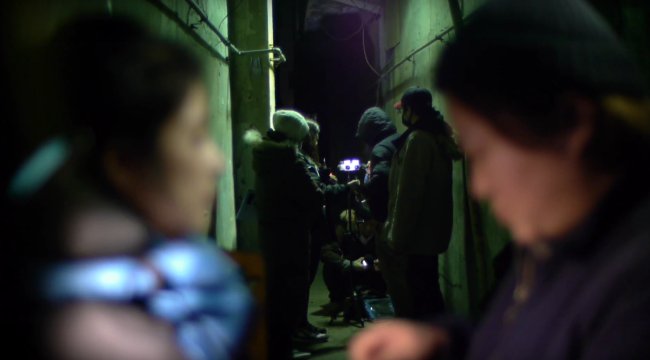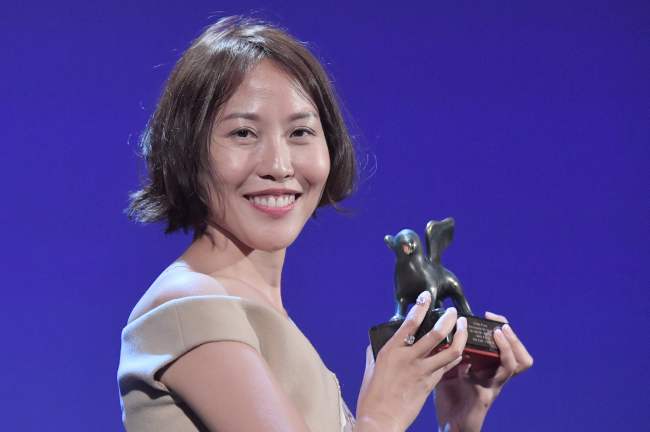[Herald Interview] Empathy without exploitation
Gina Kim’s award-winning VR film ‘Bloodless’ features murder victim’s final minutes
By Rumy DooPublished : Sept. 15, 2017 - 15:46
Is it possible to create a work of art about a murder without any depiction of brutality? Is it possible to convey a female victim’s suffering without exploiting her body? These were the questions director Gina Kim posed to herself during the creation of her virtual reality film “Bloodless.”
The work won the award for best virtual reality story at the recently concluded Venice International Film Festival. “Bloodless” is relatively bloodless. However, it is blood curdling, at an entirely different level, thanks to the VR experience.
Upon donning a Galaxy Gear VR headset, the viewer is transported to the current-day US Army camp town of Dongducheon in Gyeonggi Province. Korean residents walk by. US Army soldiers walk by. A woman, at once vivid and spectral, walks by, and we are allowed to witness the last few minutes of her life.
It’s a quiet but shockingly immersive journey. The viewer feels very present in the area’s bleak streets, but is at once formless and helpless, unable to control anything that occurs. At the same time, the viewer is given immense freedom, one that we are not accustomed to in traditional, 2-D screen films: Our gaze is given the liberty to roam and focus on any aspect of the 360-degree environment we choose. A sense of inescapable seclusion is also present. Being locked into the virtual reality world through the mobile virtual reality headset is a solitary experience, unlike collectively watching a film in a theater.
The work won the award for best virtual reality story at the recently concluded Venice International Film Festival. “Bloodless” is relatively bloodless. However, it is blood curdling, at an entirely different level, thanks to the VR experience.
Upon donning a Galaxy Gear VR headset, the viewer is transported to the current-day US Army camp town of Dongducheon in Gyeonggi Province. Korean residents walk by. US Army soldiers walk by. A woman, at once vivid and spectral, walks by, and we are allowed to witness the last few minutes of her life.
It’s a quiet but shockingly immersive journey. The viewer feels very present in the area’s bleak streets, but is at once formless and helpless, unable to control anything that occurs. At the same time, the viewer is given immense freedom, one that we are not accustomed to in traditional, 2-D screen films: Our gaze is given the liberty to roam and focus on any aspect of the 360-degree environment we choose. A sense of inescapable seclusion is also present. Being locked into the virtual reality world through the mobile virtual reality headset is a solitary experience, unlike collectively watching a film in a theater.

“All the information is given in a very loosely connected way. That was my intention, for the viewer to soak it all in. This is a military camp town. I wanted to show them, how fascinating and how depressing it is,” Kim told The Korea Herald in an interview Thursday at the Museum of Modern and Contemporary Art, Seoul, where the film was available for viewing.
By the end of the 12-minute film, the viewer has witnessed the infamous 1992 murder on which this documentary film is based. The case involved a US Army soldier stationed in Dongducheon who brutally raped and killed a female Korean sex worker. The sensational media coverage of the horrific murder included images of the victim’s body lying naked in a room, drenched in blood with various objects inserted into various bodily orifices.
The murder suspect was arrested by Korean police two days later and turned over to the USFK authorities, per the Statute of Forces Agreement between the two countries. Mass protests demanding that the soldier be tried in the Korean courts ensued, and he was eventually sentenced to 15 years in jail by a Korean court.
“I took part in the protests as a college freshman,” said Kim, who was a Western art major at Seoul National University at the time.
“Every time I saw (the victim's) brutally mutilated body being endlessly reproduced in posters and flyers, I saw her dignity being once again destroyed.”
With the incident deeply entrenched in her mind, Kim struggled for 25 years to find a way to transpose the historical and political issue of camp town sex workers into a personal and concrete experience without the element of exploitation.
“But I kept coming up against the fact that I could not cinematically represent the story without exploiting the image (of the victim) and thereby reproducing the original violence itself,” she said.
The “absence of the body” and a refusal to indulge in the gory details were the core ideas from which “Bloodless” sprouted. But how does one make people feel without showing the body? “That was a paradox to begin with,” Kim said.
After careful construction, the feat has been achieved brilliantly in Kim’s film.
The despair of the town, the melancholy of the dilapidated motel room where the crime occurred, the horror of the murder, the loneliness the victim must have felt during the last few minutes of her existence all seep through -- but not once is the woman’s naked body shown. Not a single brutal act is depicted.

Though films dealing with murder cases and important historical events abound, almost all tend to harbor some inevitable element of voyeurism, Kim noted. Stories of violence in traditional cinema ultimately end up as variations of entertainment.
“To put it very shortly and bluntly, any representation of anything is exploitation. But the question is, to what end? Where do you compromise?”
After discovering VR a few years ago, Kim was stunned. This immersive medium, she felt, ensured that the viewer could no longer be a “passive spectator, who can take voyeuristic pleasure from a spectacle in front of them, and at a distance.”
“Bloodless” was shot with eight GoPro cameras. The images were stitched together in a technologically advanced and expensive post-production process. The venture was backed by Venta VR, a Korean producer of VR video content, and the Dankook University Graduate School of Cinematic Contents.

VR has emerged as a new storytelling medium. Venice became the first film festival in the world to create a competition category for virtual reality films. It dedicated an entire island to its newly built, state-of-the art VR theaters. The upcoming Busan International Film Festival will also offer VR screenings.
Until now, creators have focused on the “experience” aspect of virtual reality, which allows the viewer to be taken away to a fantastical world of animated gun fights and car chases. For Kim, however, VR meant a “completely new way of creating empathy.”
“A lot of people focus on the fact that it allows you to experience something. The question is ultimately, to what end? It’s fascinating, but to what end? Unless you do it carefully, it can become really sadistic, a self-indulgence of the creator. I wanted to do the opposite.”

It seems fitting that empathy lies as the heart of Kim’s works -- a “sense of dislocation” is what has come to define her, she said.
The 43-year-old filmmaker earned a master’s degree in film at the California Institute of the Arts and taught at Harvard University’s Department of Visual and Environmental Studies. Kim, who has served as a jury member at the Venice film fest, is currently a professor of film at the University of California, Los Angeles.
During her time in Harvard, in particular, surrounded by mostly Caucasian, male professors, Kim had felt an extreme sense of displacement. The department did not have a single Korean student back then.
“There are two sides to it. Once you realize that you’re so extremely different from the rest of the group, in the end, you basically give up the idea of trying to fit in. That perspective can be nurturing and nourishing as an artist.
“But there is also a need for support. If you don’t have that group of people who really understand you and inspire you, it can become very isolating and difficult. But ultimately, I believe that people should be allowed to be who they are, beyond anybody’s expectations.”

But Kim believes the sense of being an outsider reaches beyond differences in nationality. Regardless of the environment, there are types of people who inherently feel out of place, Kim said. “You could have lived in one place your whole life, surrounded by homogenous people, and still feel distanced from your setting. Actually, I believe that anybody who is keenly aware of this and in search of his or her identity feels that way.”
These days, the constitution of her classrooms is becoming increasingly diverse, she pointed out.
“One student was Arabic and raised in the UK but still wore a hijab. Yet she is completely British. Do I want to define her as either? That would be so silly. She’s both and more. The total can be greater than the sum of each element. People are diverse and that’s healthy.”
Every film Kim has worked on has involved a co-production by two or more countries, with multinational actors.
In 1995, upon moving to the US, Kim shot “Gina Kim’s Video Diary,” which presents a vision of the modern female nomad traveling fluidly between Asia and America, and was screened at the Berlin Film Festival. “Invisible Light” (2003) tracks the physical and psychological journeys of two Korean and Korean-American women. “Never Forever” (2007), the first coproduction between the US and Korea, engages the conventions of melodrama to examine gender, sexuality, race and class.
“Final Recipe” (2013) is a Thai-Korean production and the first English-language film made by an Asian director with an all-Asian cast.
Such transnational film projects are widely regarded as risky. Failing to deliver a coherent cultural voice, projects often end up a jumble and a flop, unable to relate to any target country’s audience.
“I think ultimately, (transnational film projects) should come down to one last voice -- that of the director,” said Kim. “Someone who really understands the meaning of diversity.”
Kim’s films have received varied responses in different countries. In Korea, “Never Forever” was seen as transcending the typical melodrama genre. In France, critics focused more on the issues of class.
“You can’t speak to different groups of people on the same note, probably,” she said. “But there is a universal, common thread that can resonate to everyone, albeit in different ways. It’s important to find it. And it cannot be faked.”
“Bloodless” will be screened at the Busan International Film Festival, which will take place from Oct. 12-21.
By Rumy Doo (doo@heraldcorp.com)








![[Graphic News] More Koreans say they plan long-distance trips this year](http://res.heraldm.com/phpwas/restmb_idxmake.php?idx=644&simg=/content/image/2024/04/17/20240417050828_0.gif&u=)
![[KH Explains] Hyundai's full hybrid edge to pay off amid slow transition to pure EVs](http://res.heraldm.com/phpwas/restmb_idxmake.php?idx=644&simg=/content/image/2024/04/18/20240418050645_0.jpg&u=20240419100350)





![[From the Scene] Monks, Buddhists hail return of remains of Buddhas](http://res.heraldm.com/phpwas/restmb_idxmake.php?idx=652&simg=/content/image/2024/04/19/20240419050617_0.jpg&u=20240419175937)

![[KH Explains] Hyundai's full hybrid edge to pay off amid slow transition to pure EVs](http://res.heraldm.com/phpwas/restmb_idxmake.php?idx=652&simg=/content/image/2024/04/18/20240418050645_0.jpg&u=20240419100350)

![[Today’s K-pop] Illit drops debut single remix](http://res.heraldm.com/phpwas/restmb_idxmake.php?idx=642&simg=/content/image/2024/04/19/20240419050612_0.jpg&u=)